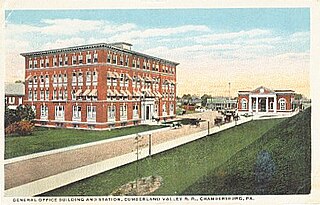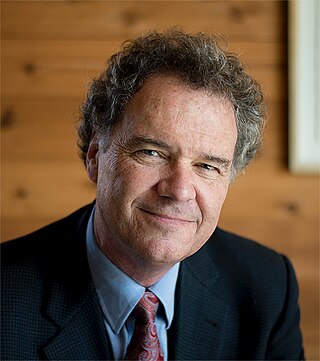Related Research Articles

Adams County is a county in the Commonwealth of Pennsylvania. As of the 2020 census, the population was 103,852. Its county seat is Gettysburg. The county was created on January 22, 1800, from part of York County, and was named for the second President of the United States, John Adams. On July 1–3, 1863, a crucial battle of the American Civil War was fought near Gettysburg; Adams County as a result is a center of Civil War tourism.

Franklin County is a county in the Commonwealth of Pennsylvania. As of the 2020 census, the population was 155,932 Its county seat is Chambersburg.

Chambersburg is a borough in and the county seat of Franklin County, in the South Central region of Pennsylvania, United States. It is in the Cumberland Valley, which is part of the Great Appalachian Valley, and 13 miles (21 km) north of Maryland and the Mason-Dixon line and 52 miles (84 km) southwest of Harrisburg, the state capital. According to the United States Census Bureau, Chambersburg's 2020 population was 21,903. When combined with the surrounding Greene, Hamilton, and Guilford Townships, the population of Greater Chambersburg is 52,273 people. The Chambersburg, PA Metropolitan Statistical Area includes surrounding Franklin County, and in 2010 included 149,618 people.

John Peter Gabriel Muhlenberg was an American clergyman and Continental Army soldier during the American Revolutionary War.

Staunton is an independent city in the U.S. Commonwealth of Virginia. As of the 2020 census, the population was 25,750. In Virginia, independent cities are separate jurisdictions from the counties that surround them, so the government offices of Augusta County are in Verona, which is contiguous to Staunton. Staunton is a principal city of the Staunton-Waynesboro Metropolitan Statistical Area, which had a 2010 population of 118,502. Staunton is known for being the birthplace of Woodrow Wilson, the 28th U.S. president, and as the home of Mary Baldwin University, historically a women's college. The city is also home to Stuart Hall, a private co-ed preparatory school, as well as the Virginia School for the Deaf and Blind. It was the first city in the United States with a fully defined city manager system.

John Daniel Imboden, American lawyer, Virginia state legislator, and a Confederate army general. During the American Civil War, he commanded an irregular cavalry force. After the war, he resumed practicing law, became a writer, and was active in land development founding the town of Damascus, Virginia.

John McCausland, Jr. was a brigadier general in the Confederate army, famous for the ransom of Hagerstown, Maryland, and the razing of Chambersburg, Pennsylvania, during the American Civil War.
The Great Wagon Road was an improved trail through the Great Appalachian Valley from Pennsylvania to North Carolina, and from there to Georgia in colonial America.

Edward McPherson was an American newspaper editor and politician who served two terms in the United States House of Representatives, as well as multiple terms as the Clerk of the House of Representatives. As a director of the Gettysburg Battlefield Memorial Association, he effected efforts to protect and mark portions of the Gettysburg Battlefield.

The Great Indian Warpath (GIW)—also known as the Great Indian War and Trading Path, or the Seneca Trail—was that part of the network of trails in eastern North America developed and used by Native Americans which ran through the Great Appalachian Valley. The system of footpaths extended from what is now upper New York to deep within Alabama. Various Native peoples traded and made war along the trails, including the Catawba, numerous Algonquian tribes, the Cherokee, and the Iroquois Confederacy. The British traders' name for the route was derived from combining its name among the northeastern Algonquian tribes, Mishimayagat or "Great Trail", with that of the Shawnee and Delaware, Athawominee or "Path where they go armed".

The Cumberland Valley Railroad was an early railroad in Pennsylvania, United States, originally chartered in 1831 to connect with Pennsylvania's Main Line of Public Works. Freight and passenger service in the Cumberland Valley in south central Pennsylvania from near Harrisburg to Chambersburg began in 1837, with service later extended to Hagerstown, Maryland, and then extending into the Shenandoah Valley to Winchester, Virginia. It employed up to 1,800 workers.
William Armstrong was an American lawyer, civil servant, politician, and businessperson. He represented Hampshire County in the Virginia House of Delegates from 1818 to 1820, and Virginia's 16th congressional district in the United States House of Representatives from 1825 to 1833.

Edward Lynn "Ed" Ayers is an American historian, professor, administrator, and university president. In July 2013, he was awarded the National Humanities Medal by President Barack Obama at a White House ceremony for Ayers's commitment “to making our history as widely available and accessible as possible." He served as the president of the Organization of American Historians in 2017–18.
Digital history is the use of digital media to further historical analysis, presentation, and research. It is a branch of the digital humanities and an extension of quantitative history, cliometrics, and computing. Digital history is commonly digital public history, concerned primarily with engaging online audiences with historical content, or, digital research methods, that further academic research. Digital history outputs include: digital archives, online presentations, data visualizations, interactive maps, time-lines, audio files, and virtual worlds to make history more accessible to the user. Recent digital history projects focus on creativity, collaboration, and technical innovation, text mining, corpus linguistics, network analysis, 3D modeling, and big data analysis. By utilizing these resources, the user can rapidly develop new analyses that can link to, extend, and bring to life existing histories

The current Franklin County Courthouse in Chambersburg, Pennsylvania, built in 1865, is the third courthouse building on the site. The site was originally purchased from Colonel Benjamin Chambers in 1785.

Alexander Kelly McClure was an American politician, newspaper editor, and writer from Pennsylvania. He served as a Republican member of the Pennsylvania House of Representatives from 1858 to 1859 and 1865 to 1866 as well as a member of the Pennsylvania State Senate for the 18th district in 1861 and the 4th district from 1873 to 1874. He was a prominent supporter, correspondent, and biographer of President Abraham Lincoln. He was the editor of the Franklin Repository newspaper in Chambersburg, Pennsylvania and of the Philadelphia Times. The borough of McClure, Pennsylvania, and the Alexander K. McClure School in Philadelphia, Pennsylvania, are named in his honor.
Kenton Harper was an American newspaper editor, soldier, Indian agent, plantation owner, banker and politician. An officer of the Virginia militia then U.S. Army during the Mexican–American War, Harper later became a Confederate general officer during the American Civil War, and reportedly helped nickname Stonewall Jackson.

Public Opinion is a morning newspaper published seven days a week in the Greater Chambersburg area, including Franklin, Cumberland and Fulton counties PA.
Scotland is an unincorporated community and census-designated place (CDP) in Greene Township, Franklin County, Pennsylvania, United States. The community was named after Scotland, the ancestral home of an early settler. As of the 2010 census the population was 1,353.

The 1944 United States presidential election in Virginia took place on November 7, 1944, throughout the 48 contiguous states. Voters chose 11 representatives, or electors to the Electoral College, who voted for president and vice president.
References
- ↑ Wilson, May Wright (1993). From the Valley of the Shadow. ISBN 0806245808.
- ↑ William G. Thomas III and Edward L. Ayers. "The Differences Slavery Made: A Close Analysis of Two American Communities". University of Virginia. Retrieved 4 August 2011.
- ↑ "The Valley of the Shadow: Two Communities in the American Civil War". University of Virginia. Retrieved 4 August 2011.
- ↑ Elsa A. Nystrom and Justin A. Nystrom (July 2005). "Beyond the Valley of the Shadow: Taking Stock of the Virginia Center for Digital History". MERLOT Journal of Online Learning and Teaching. 1 (1). PDF available here